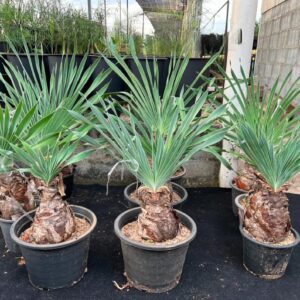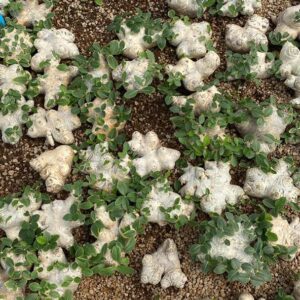pachypodium bispinosum
Pachypodium bispinosum is a succulent shrublet belonging to the family Apocynaceae. It is native to South Africa, primarily found in the Eastern Cape Province, where it thrives in stony, dry succulent scrub vegetation, often on rocky slopes.
-
: The plant features a swollen, tuberous stem (caudex) that is partially buried beneath the soil. The caudex can grow up to 60 cm tall and 25 cm in diameter. Thick bonsai-like branches sprout from the top, lined with paired, straight spines measuring 10–20 mm long.
-
: Narrow, dark green leaves are scattered or tufted along the branches. They are less hairy than other species in the genus, with margins curling downward distinctly.
-
: From August to December (or spring to summer), it produces bell-shaped flowers in shades of purple to pink. These flowers are clustered at the tips of branches and measure about 15–20 mm in diameter. The species is known for being highly floriferous in cultivation.
-
Found almost exclusively in the Eastern Cape Province and parts of the eastern Western Cape of South Africa.
-
Grows in xeric habitats on stony terrain among dry succulent scrub vegetation. It is well-adapted to survive harsh conditions like drought and intense heat due to its water-storing caudex.
-
: Suitable for USDA hardiness zones 9b to 11b (temperatures ranging from -3.9 °C to +10 °C).
-
: Requires well-drained soil and minimal watering during summer; avoid watering entirely during winter as it is prone to rot under wet conditions. It is intolerant of frost and cold temperatures.
-
:
-
Family: Apocynaceae
-
Genus: Pachypodium
-
Synonyms: Belonites bispinosa, Echites bispinosa, Pachypodium glabrum.
-
This species is assessed as “Least Concern” on the Red List of South African Plants, indicating it is not currently threatened
How do I care for Pachypodium bispinosum at home
To care for Pachypodium bispinosum at home, follow these guidelines:
Light Requirements
-
Place the plant in a location with bright, indirect sunlight or near a south-facing window. It thrives in high light conditions and does not tolerate low light.
-
If transitioning outdoors, gradually introduce it to full sun to prevent sunburn.
Watering
-
During the active growing season (spring and summer), water thoroughly but allow the soil to dry out between waterings. Avoid overwatering as it can lead to root rot.
-
In winter, reduce watering significantly, as the plant enters dormancy. Water sparingly, just enough to prevent the roots from drying out completely.
-
For indoor plants in a 5-inch pot, approximately 0.5 cups of water every 12 days is recommended under moderate light conditions.
Soil
-
Use well-draining soil, such as a mix of cactus soil with added perlite or coarse sand. A gritty mix prevents water retention and promotes healthy root growth.
-
Avoid over-potting; use a pot that is only slightly larger than the caudex to prevent excess moisture retention.
Temperature and Humidity
-
Maintain temperatures above 50°F (10°C). The plant is sensitive to frost and cold temperatures.
-
Keep it in a warm, dry environment with good air circulation.
Fertilization
-
Feed lightly during the growing season with a balanced liquid fertilizer diluted to half strength. Avoid fertilizing during dormancy.
Repotting
-
Repot every 1–2 years or when the plant outgrows its pot. Choose a pot that accommodates its caudex growth without being too large.
General Tips
-
Avoid placing the plant in areas with poor ventilation or excessive humidity.
-
Monitor for pests like mealybugs and treat promptly if detected.
-
Handle carefully due to its spines and toxic sap.
By providing ample light, controlled watering, and proper soil conditions, your Pachypodium bispinosum will thrive as an attractive and unique houseplant.
What type of potting mix is best for Pachypodium bispinosum
The best potting mix for Pachypodium bispinosum should be gritty and well-draining to prevent water retention, which can lead to root rot. Here are the recommended components:
-
: At least 50% of the mix should consist of coarse sand, small gravel, or perlite. This ensures excellent drainage and aeration.
-
: Use a light potting soil or general-purpose compost to provide nutrients. Avoid heavy soils like John Innes, as they retain too much moisture.
-
: Aquarium gravel or small rocks can be mixed in for extra drainage and stability.
-
Ensure the pot has drainage holes to prevent water from pooling at the bottom.
-
Use an unglazed clay pot if possible, as it dries out faster than plastic or glazed ceramic pots, reducing the risk of overwatering.
-
Avoid shallow containers unless displaying the plant, as its caudex grows underground and needs adequate depth.
This mix will support healthy growth while minimizing risks associated with overwatering.





Reviews
There are no reviews yet.